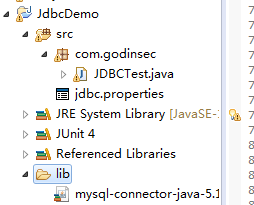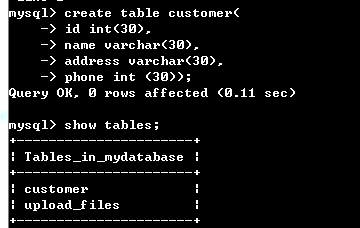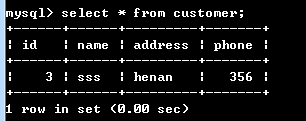几种获取数据库连接的方式
配置文件jdbc.properties
driver = com.mysql.jdbc.Driver
jdbcUrl = jdbc:mysql://localhost:3306/mydatabase
user = root
password = rootJDBCTest
package com.godinsec;
import java.io.InputStream;
import java.sql.Connection;
import java.sql.Date;
import java.sql.Driver;
import java.sql.DriverManager;
import java.sql.ResultSet;
import java.sql.SQLException;
import java.sql.Statement;
import java.util.List;
import java.util.Properties;
import org.junit.Test;
public class JDBCTest {
// //
@Test
public void testGetConnection2() throws Exception {
System.out.println(getConnection2());
}
public Connection getConnection2() throws Exception {
// 1. 准备连接数据库的 4 个字符串.
// 1). 创建 Properties 对象
Properties properties = new Properties();
// 2). 获取 jdbc.properties 对应的输入流
InputStream in = this.getClass().getClassLoader()
.getResourceAsStream("jdbc.properties");
// 3). 加载 2) 对应的输入流
properties.load(in);
// 4). 具体决定 user, password 等4 个字符串.
String user = properties.getProperty("user");
String password = properties.getProperty("password");
String jdbcUrl = properties.getProperty("jdbcUrl");
String driver = properties.getProperty("driver");
// 2. 加载数据库驱动程序(对应的 Driver 实现类中有注册驱动的静态代码块.)
Class.forName(driver);
// 3. 通过 DriverManager 的 getConnection() 方法获取数据库连接.
return DriverManager.getConnection(jdbcUrl, user, password);
}
// //
/**
* DriverManager 是驱动的管理类. 1). 可以通过重载的 getConnection() 方法获取数据库连接. 较为方便 2).
* 可以同时管理多个驱动程序: 若注册了多个数据库连接, 则调用 getConnection() 方法时传入的参数不同, 即返回不同的数据库连接。
*
* @throws Exception
*/
@Test
public void testDriverManager() throws Exception {
// 1. 准备连接数据库的 4 个字符串.
// 驱动的全类名.
String driverClass = "com.mysql.jdbc.Driver";
// JDBC URL
String jdbcUrl = "jdbc:mysql:///mydatabase";
// user
String user = "root";
// password
String password = "root";
// 2. 加载数据库驱动程序(对应的 Driver 实现类中有注册驱动的静态代码块.)
Class.forName(driverClass);
// 3. 通过 DriverManager 的 getConnection() 方法获取数据库连接.
Connection connection = DriverManager.getConnection(jdbcUrl, user,
password);
System.out.println(connection);
}
// //
/**
* Driver 是一个接口: 数据库厂商必须提供实现的接口. 能从其中获取数据库连接. 可以通过 Driver 的实现类对象获取数据库连接.
*
* 1. 加入 mysql 驱动 1). 解压 mysql-connector-java-5.1.7.zip 2). 在当前项目下新建 lib 目录
* 3). 把 mysql-connector-java-5.1.7-bin.jar 复制到 lib 目录下 4). 右键 build-path ,
* add to buildpath 加入到类路径下.s
*
* @throws SQLException
*/
@Test
public void testDriver() throws SQLException {
// 1. 创建一个 Driver 实现类的对象
Driver driver = new com.mysql.jdbc.Driver();
// 2. 准备连接数据库的基本信息: url, user, password
String url = "jdbc:mysql://localhost:3306/mydatabase";
Properties info = new Properties();
info.put("user", "root");
info.put("password", "root");
// 3. 调用 Driver 接口的 connect(url, info) 获取数据库连接
Connection connection = driver.connect(url, info);
System.out.println(connection);
}
// //
@Test
public void testGetConnection() throws Exception {
System.out.println(getConnection());
}
/**
* 编写一个通用的方法, 在不修改源程序的情况下, 可以获取任何数据库的连接 解决方案: 把数据库驱动 Driver
* 实现类的全类名、url、user、password 放入一个 配置文件中, 通过修改配置文件的方式实现和具体的数据库解耦.
*
* @throws Exception
*/
public Connection getConnection() throws Exception {
String driverClass = null;
String jdbcUrl = null;
String user = null;
String password = null;
// 读取类路径下的 jdbc.properties 文件
InputStream in = getClass().getClassLoader().getResourceAsStream(
"jdbc.properties");
Properties properties = new Properties();
properties.load(in);
driverClass = properties.getProperty("driver");
jdbcUrl = properties.getProperty("jdbcUrl");
user = properties.getProperty("user");
password = properties.getProperty("password");
// 通过反射常见 Driver 对象.
Driver driver = (Driver) Class.forName(driverClass).newInstance();
Properties info = new Properties();
info.put("user", user);
info.put("password", password);
// 通过 Driver 的 connect 方法获取数据库连接.
Connection connection = driver.connect(jdbcUrl, info);
return connection;
}
}
createStatement,execute
创建customer表
JDBCTools
package com.godinsec;
import java.io.InputStream;
import java.sql.Connection;
import java.sql.DriverManager;
import java.sql.ResultSet;
import java.sql.SQLException;
import java.sql.Statement;
import java.util.Properties;
/**
* 操作 JDBC 的工具类. 其中封装了一些工具方法 Version 1
*/
public class JDBCTools {
public static void release(ResultSet rs,
Statement statement, Connection conn) {
if(rs != null){
try {
rs.close();
} catch (SQLException e) {
e.printStackTrace();
}
}
if (statement != null) {
try {
statement.close();
} catch (Exception e2) {
e2.printStackTrace();
}
}
if (conn != null) {
try {
conn.close();
} catch (Exception e2) {
e2.printStackTrace();
}
}
}
/**
* 关闭 Statement 和 Connection
* @param statement
* @param conn
*/
public static void release(Statement statement, Connection conn) {
if (statement != null) {
try {
statement.close();
} catch (Exception e2) {
e2.printStackTrace();
}
}
if (conn != null) {
try {
conn.close();
} catch (Exception e2) {
e2.printStackTrace();
}
}
}
/**
* 1. 获取连接的方法. 通过读取配置文件从数据库服务器获取一个连接.
*
* @return
* @throws Exception
*/
public static Connection getConnection() throws Exception {
// 1. 准备连接数据库的 4 个字符串.
// 1). 创建 Properties 对象
Properties properties = new Properties();
// 2). 获取 jdbc.properties 对应的输入流
InputStream in = JDBCTools.class.getClassLoader().getResourceAsStream(
"jdbc.properties");
// 3). 加载 2) 对应的输入流
properties.load(in);
// 4). 具体决定 user, password 等4 个字符串.
String user = properties.getProperty("user");
String password = properties.getProperty("password");
String jdbcUrl = properties.getProperty("jdbcUrl");
String driver = properties.getProperty("driver");
// 2. 加载数据库驱动程序(对应的 Driver 实现类中有注册驱动的静态代码块.)
Class.forName(driver);
// 3. 通过 DriverManager 的 getConnection() 方法获取数据库连接.
return DriverManager.getConnection(jdbcUrl, user, password);
}
}
JDBCTest
package com.godinsec;
import java.io.InputStream;
import java.sql.Connection;
import java.sql.Date;
import java.sql.Driver;
import java.sql.DriverManager;
import java.sql.ResultSet;
import java.sql.SQLException;
import java.sql.Statement;
import java.util.List;
import java.util.Properties;
import org.junit.Test;
public class JDBCTest {
public <T> List<T> query(Class<T> clazz, String sql) {
return null;
}
/**
* ResultSet: 结果集. 封装了使用 JDBC 进行查询的结果. 1. 调用 Statement 对象的 executeQuery(sql)
* 可以得到结果集. 2. ResultSet 返回的实际上就是一张数据表. 有一个指针指向数据表的第一样的前面. 可以调用 next()
* 方法检测下一行是否有效. 若有效该方法返回 true, 且指针下移. 相当于 Iterator 对象的 hasNext() 和 next()
* 方法的结合体 3. 当指针对位到一行时, 可以通过调用 getXxx(index) 或 getXxx(columnName) 获取每一列的值.
* 例如: getInt(1), getString("name") 4. ResultSet 当然也需要进行关闭.
*/
@Test
public void testResultSet() {
// 获取 id=4 的 customers 数据表的记录, 并打印
Connection conn = null;
Statement statement = null;
ResultSet rs = null;
try {
// 1. 获取 Connection
conn = JDBCTools.getConnection();
System.out.println(conn);
// 2. 获取 Statement
statement = conn.createStatement();
System.out.println(statement);
// 3. 准备 SQL
String sql = "SELECT id, name, address, phone " + "FROM customer";
// 4. 执行查询, 得到 ResultSet
rs = statement.executeQuery(sql);
System.out.println(rs);
// 5. 处理 ResultSet
while (rs.next()) {
int id = rs.getInt(1);
String name = rs.getString("name");
String email = rs.getString(3);
String birth = rs.getString(4);
System.out.println(id);
System.out.println(name);
System.out.println(email);
System.out.println(birth);
}
} catch (Exception e) {
e.printStackTrace();
} finally {
// 6. 关闭数据库资源.
JDBCTools.release(rs, statement, conn);
}
}
@Test
public void testUpdateStatement() throws Exception {
String sql = "update customer set name='sss' where id = '3'";
update(sql);
}
/**
* mysql> UPDATE runoob_tbl -> SET runoob_title='Learning JAVA' -> WHERE
* runoob_id=3;
*
* 通用的更新的方法: 包括 INSERT、UPDATE、DELETE 版本 1. insert into customer
* values(3,'xiaofang','henan',356)
*/
public void update(String sql) {
Connection conn = null;
Statement statement = null;
try {
conn = JDBCTools.getConnection();
statement = conn.createStatement();
statement.executeUpdate(sql);
} catch (Exception e) {
e.printStackTrace();
} finally {
JDBCTools.release(statement, conn);
}
}
/**
* 通过 JDBC 向指定的数据表中插入一条记录.
*
* 1. Statement: 用于执行 SQL 语句的对象 1). 通过 Connection 的 createStatement() 方法来获取
* 2). 通过 executeUpdate(sql) 可以执行 SQL 语句. 3). 传入的 SQL 可以是 INSRET, UPDATE 或
* DELETE. 但不能是 SELECT
*
* 2. Connection、Statement 都是应用程序和数据库服务器的连接资源. 使用后一定要关闭. 需要在 finally 中关闭
* Connection 和 Statement 对象.
*
* 3. 关闭的顺序是: 先关闭后获取的. 即先关闭 Statement 后关闭 Connection
*/
@Test
public void testInsertStatement() throws Exception {
// 1. 获取数据库连接
Connection conn = null;
Statement statement = null;
try {
conn = JDBCTools.getConnection();
// 3. 准备插入的 SQL 语句
String sql = "insert into customer values(3,'xiaofang','henan',356)";
System.out.println(sql);
// 1). 获取操作 SQL 语句的 Statement 对象:
// 调用 Connection 的 createStatement() 方法来获取
statement = conn.createStatement();
// 2). 调用 Statement 对象的 executeUpdate(sql) 执行 SQL 语句进行插入
statement.executeUpdate(sql);
} catch (Exception e) {
e.printStackTrace();
} finally {
try {
// 5. 关闭 Statement 对象.
if (statement != null)
statement.close();
} catch (Exception e) {
// TODO Auto-generated catch block
e.printStackTrace();
} finally {
// 2. 关闭连接
if (conn != null)
conn.close();
}
}
}
}
看看插入结果:
看看修改的结果:
看看查询的结果:
3
sss
henan
356




























 被折叠的 条评论
为什么被折叠?
被折叠的 条评论
为什么被折叠?








